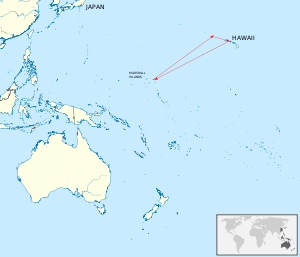| Operation K | |||||||
|---|---|---|---|---|---|---|---|
| Part of the Pacific Theater of World War II | |||||||
 Approximate route of Operation K. | |||||||
| |||||||
| Belligerents | |||||||
|
|
| ||||||
| Commanders and leaders | |||||||
| None | Hisao Hashizume | ||||||
| Strength | |||||||
| None |
2 Kawanishi H8Ks 3 submarines | ||||||
| Casualties and losses | |||||||
| Minimal private property damage | Loss of submarine I-23 | ||||||
Operation K (K作戦, Kē-Sakusen) was a Japanese naval operation in World War II, intended as reconnaissance of Pearl Harbor and disruption of repair and salvage operations following the surprise attack on 7 December 1941. It culminated on 4 March 1942, with an unsuccessful attack carried out by two Kawanishi H8K "Emily" flying boats. This was the longest distance ever undertaken by a two-plane bombing mission, and one of the longest bombing sorties ever planned without fighter escort.[1][2]
- ^ Budnick, p. 95
- ^ "Japan's little-known 2nd surprise attack on Hawaii failed in more ways than one". Stars_and_Stripes. 28 February 2018.